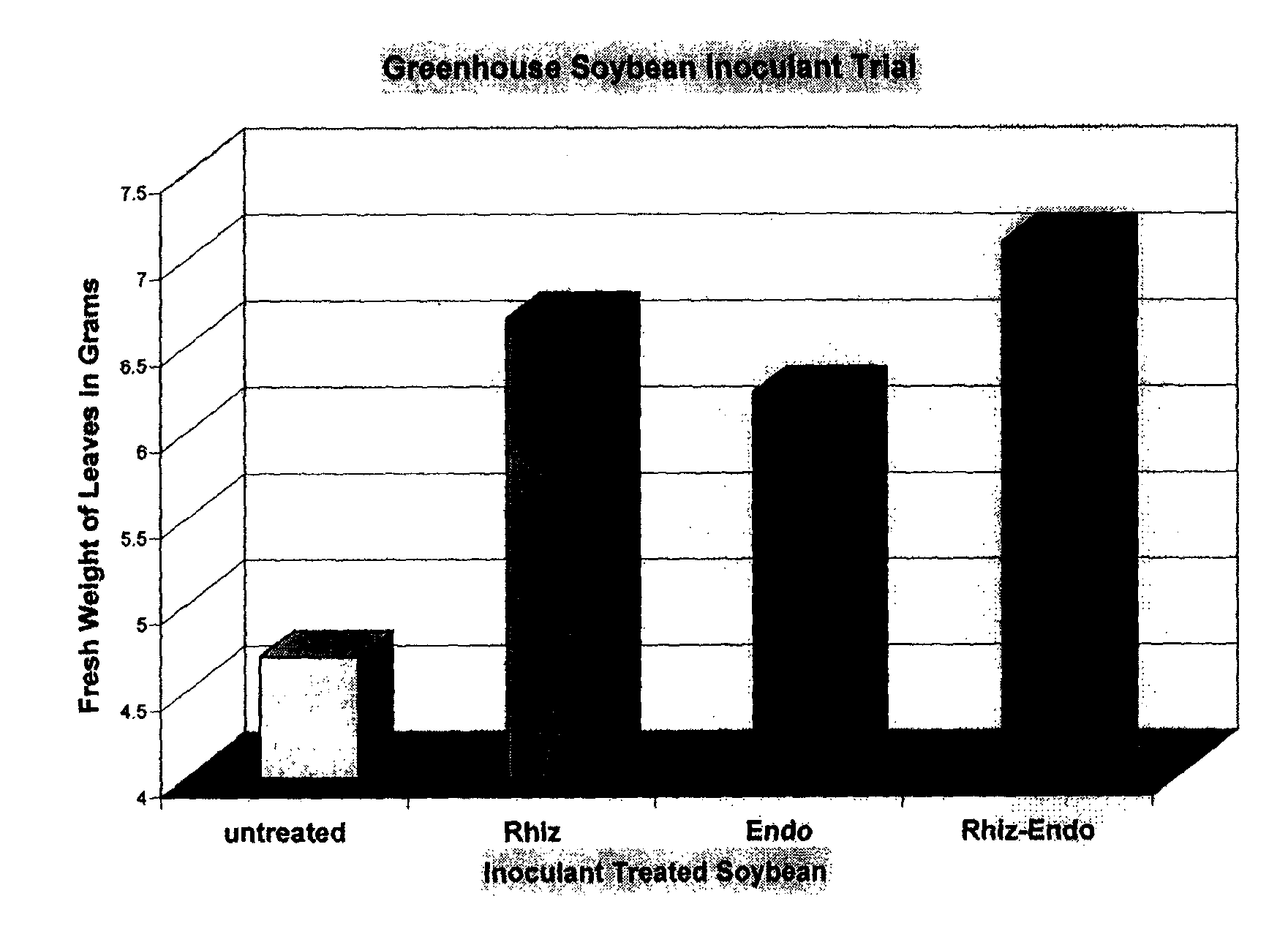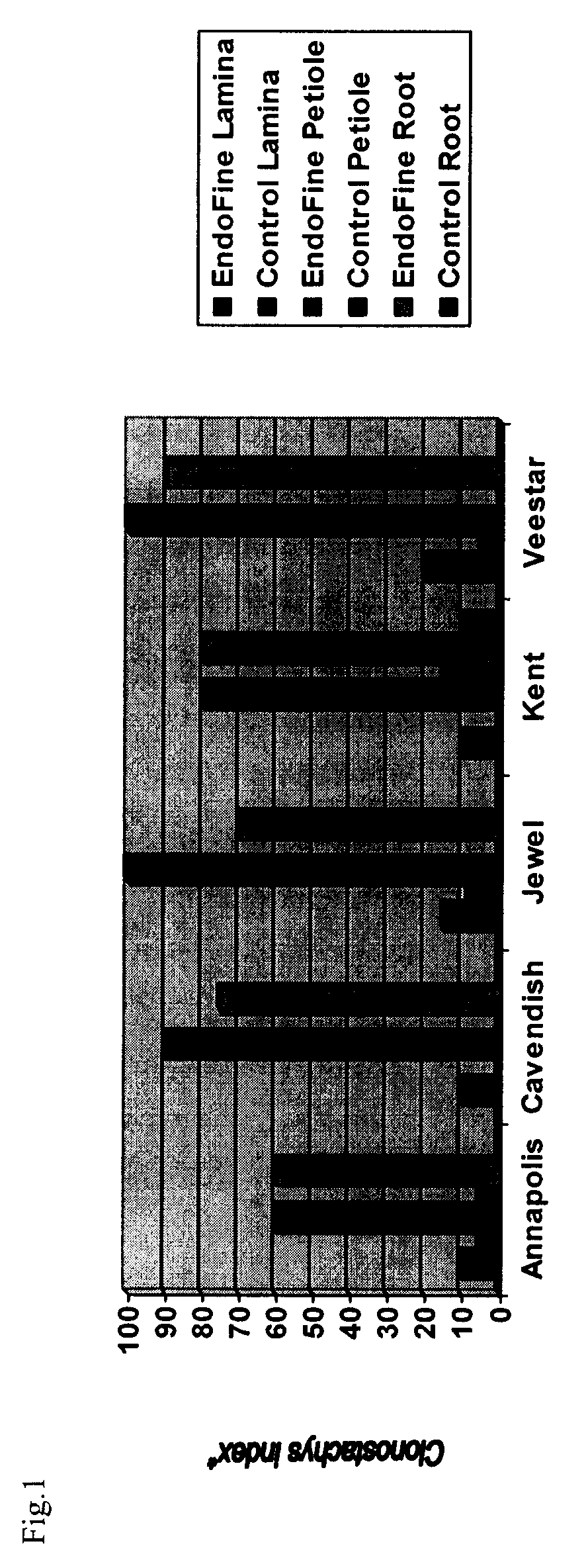Production and use of endophytes as novel inoculants for promoting enhanced plant vigor, health, growth, yield reducing environmental stress and for reducing dependency on chemical pesticides for pest control
a technology of endophytes and inoculants, which is applied in the direction of fermentation, plant growth regulators, fungicides, etc., can solve the problems of little or no documentation, difficult to sustain the health and productivity of crops, and endophytes such as i>c. rosea /i>may remain relatively ineffective as inoculants
- Summary
- Abstract
- Description
- Claims
- Application Information
AI Technical Summary
Benefits of technology
Problems solved by technology
Method used
Image
Examples
example 1
[0107]The unique method of preparation and know-how linked to the performance claims in this invention involves identifying performance standards that produce: ** ** (also note references: Schroeder's, H. J. Samuels, G. J., Siefert, K. A. & Gams, W. (1999) Classification of the myoparasite Giocladium roseum in Clonostachys as C. rosea, its relationship to Bionectria ochroleuca and notes on other Gliocaldium like fungi. Mycologia 91, 365-383. Domsch, K. H., Gams, W., Anderson, Traute-Heide (1980) Compendium of Soil Fungi Volume 1, Academic Press, A Subsidiary of Harcourt Brace Jovanovich, Publishers)[0108](1) A percent acceptable recovery method of a minimum of 60% conidia / viable spores from a solid matrix.[0109](2) An analytical range: of 0.1 to 5×10 to the 9th (or higher) CFU for pure inoculum powder (concentrate). Preferred concentrations range from 104 to 1012 CFU / gram, especially from 106 to 1010 CFU / gram, particularly from 107 to 1010 CFU / gram, and more especially from 107 to 1...
example 2
[0119]The invention also involved developing a consistent method for determining the viable number of spores per gram of powder (CFU spores / g). This was done by place 0.1 g powder in 9.9 ml sterile distilled water in a sterile test tube. (=10 minus 2 dilution). Shake thoroughly, and continuing the dilution series with 1.0 ml in 9.0 ml each time. Zero point one ml (0.1 ml) of each dilution is then onto PDTSA (in-house source from Adjuvants Plus Inc.) in Petri dishes at least 3 replicates. The Petri dishes are then incubated for 4-5 days until colonies have developed, and count the colonies. Multiply the colony count by the dilution factor to give number of viable (colony-producing) spores per gram powder. For example, the first dilution of 10 to minus 2 becomes 10 to 3 because only 0.1 was used for plating, so in this instance multiply the colony by 1000.
[0120]For determining the number of viable spores per gram of grain substrate, 1 g of dried grain is sampled randomly from stored i...
example 3
[0121]All living fungal / bacterial endophytes are highly susceptible to degradation due to a number of factors e.g. high temperatures (4° C. or higher), halogens in water e.g. chlorinated water, bacterial contamination, etc. This invention also involves the preparation of a novel formulation that provides stability for viable spores and the formulation of the products for practical use and application to roots, stems, leaves, flowers, bulbs, etc of plants as a water based sprayable formulations or as a dusts for other uses e.g. seed treatment.
[0122]The objective with final formulations is to have stable viable spores in the finished product at various desired levels i.e. from 0.1 to minimums of 2×107 spores / g. or higher. The fine powder of concentrated C. rosea (100 mesh) is mixed with an inert carrier (calcium carbonate 15-30% w / w; talc 13-15% w / w and sodium dibutylnaphthalene sulfonate (75-78% w / w and, sodium sulfate 13-20% w / w) for a product example EndoFine® of 14.5% w / w concentr...
PUM
| Property | Measurement | Unit |
|---|---|---|
| pH | aaaaa | aaaaa |
| turnaround time | aaaaa | aaaaa |
| area | aaaaa | aaaaa |
Abstract
Description
Claims
Application Information
 Login to View More
Login to View More - R&D
- Intellectual Property
- Life Sciences
- Materials
- Tech Scout
- Unparalleled Data Quality
- Higher Quality Content
- 60% Fewer Hallucinations
Browse by: Latest US Patents, China's latest patents, Technical Efficacy Thesaurus, Application Domain, Technology Topic, Popular Technical Reports.
© 2025 PatSnap. All rights reserved.Legal|Privacy policy|Modern Slavery Act Transparency Statement|Sitemap|About US| Contact US: help@patsnap.com



